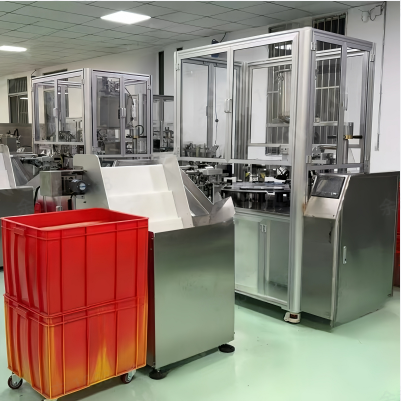Kā Automātiskajiem segšanas aparātiem Efektivitātes paaugstināšana
Chuck, Snap un Spindle capperi salīdzinājums
Automātiskajiem segšanas aparātiem ir būtiskas modernajās ražošanas līnijās, galvenokārt sadaloties trīs kategorijās: Chuck, Snap un Spindle apkavu iekšķērtnes. Katrs tips sniedz unikālus risinājumus ar atšķirīgiem darbības mehānismiem. Chuck apkavu iekšķērtnes izmanto iekšķērtni, lai apkaķētu apkavus ar precīzu momenta kontroli, kas tos padara ideālos jutīgajiem pielietojumiem, kas saistīti ar šraubkavām un apkavām ar aizsardzību pret nelegālu atvēršanu. Otrā pusē, Snap apkavu iekšķērtnes izmanto mehānisko spiedienu, lai ātri uzliktu apkavus, kas ir noderīgi nozarēs, kur nepieciešama ātra lietošana, piemēram, gāzains dzēriens. Spindle apkavu iekšķērtnes izmanto ritināmo disku, lai uzšraubtu apkavus uz burkuļiem, piedāvājot augstas ātruma pielāgojamību dažādiem apkavu un burkuļu formātiem.
Katra tīpa priekšrocības un ierobežojumi ir vērtīgi uzmanības pievienošanai. Čakliskie kapsatori nodrošina precizitāti un konsekventumu, kas ir būtiski farmaceitiskajām nozarēm, kurās precizitāte novērš izplūdes un saslimšanu. Tomēr ar elastīgiem vai uzspiedumiem piespristiem kapjiem tie var būt maz efektīvāki. Savukārt, uzspieduma kapsatori ir vienkārši un ātri, taču var nebūt piemēroti kapjiem, kuriem nepieciešamas noteiktas sprieguma iestatījumi. Spirālveida kapsatori izcīnājas dēļ savām augstas ātruma iespējām un daudzveidībai, tomēr tiem bieži prasa pielāgojumus atšķirīgiem flāsku formātiem. Nozares eksperti norāda, ka derīgās mašīnas izvēle atkarīga no specifiskajiem ražošanas vajadzībām, līdzsvarojot starp efektivitāti un ražošanas ātrumu, kā to parāda statistiskie dati, salīdzinot darbības rezultātus dažādos nozares risinājumos.
Ātrums un precizitāte slēgšanas operācijās
Automātiskie segšanas aparāti nozīmīgi palielina segšanas darbību ātrumu un precizitāti, kas ir būtiski, lai saglabātu produktu kvalitāti un nodrošinātu patērētāju apmierinātību. Ar savu spēju atkārtoti piemērot vienotu momentu un uzturēt slēguma konstantību šie ierīces aizsargā produktu kvalitāti un ilgtspēju, sākot no dzērieniem līdz farmaceitiķiem. Segšanas precizitāte ne tikai novērš saslimšanu un izvirdumus, bet arī atbalsta patērētāju uzticību, nodrošinot nepiederošu uzslēgumu.
Nopietni neatkarīgu nozarē ziņojumi atbalsta priekšrocības automātiskajiem segšanas aparātiem , demonstrējot uzlabotus izlaišanas tempus. Piemēram, sula ražošanas uzņēmums paziņoja par 40% pieaugumu kapacitātē pēc automatizētas galvenes ieviešanas, nozīmīgi samazinot noraidījuma līmeni dēļ trūkumiem. Šīs atklājumus atkārto dažādu nozaru gadījumu pētījumi, kurās uzņēmumi pieredzējuši zīmīgus efektivitātes un izlaišanas uzvaru, izmantojot šos modernos risinājumus savās slēgšanas operācijās. Automātiskas galvenes mašīnas spēlē galveno lomu produktivitātes palielināšanā un produktu drošības nodrošināšanā, kas ir būtiski kompetitīvā tirgū ar stingriem standartiem.
Integrējot aizpildīšanu un galvenēšanu optimālam darba plūsmas veicināšanai
Sinchronizēta sistēma priekšrocības
Integrējot sinhronizētas aizpildīšanas un apkārtošanas sistēmas, ražotājiem, kas vēlas optimizēt darbplūsmu, piedāvājas daudzus priekšrocības. Pirmkārt, sinhronizācija palielina efektivitāti, vienkāršojot operācijas un atļaujot abām procesiem darboties vienlaikus bez roku piesaistes, tādējādi samazinot darba izmaksas. Turklāt sinhronizētās sistēmas samazina kļūdu biežumu, nodrošinot saskaņotību un kvalitāti ražošanas ciklos. Rastos no dažādu nozares ziņojumiem atbalsta apgalvojumu, ka sinhronizētās sistēmas ved pie kopējām ražošanas cikla laika samazinājumiem, parādot efektivitātes uzvaras salīdzinājumā ar tradicionālajām iestatījumiem. Piemēram, uzņēmumi kā Fogg Filler veiksmīgi ir ieviesuši šādas integrētās risinājumus, parādot nozīmīgus uzlabojumus efektivitātei un produktu izveidei.
Pielāgoti risinājumi nozares vajadzībām
Automātiskie aizpildīšanas un apkopšanas sistēmu var pielāgot, lai atbilstu konkrētajiem nozares prasībām, izmantojot pielāgotus risinājumus. Šī elastīgums ļauj ražotājiem pielāgoties dažādiem produktu veidiem un pakotnes izmēriem, ar kuriem viņi katru dienu strādā. Piemēram, pienu un šķīstošo barības vielu nozarēs ir ieguvušās priekšrocības no pielāgotiem risinājumiem, piemēram, ProMach Matrix zīmes Elete Premier, kas paredzēts sieru apkopējiem ar dažādiem vajadzību apjomiem. Klientu novērtējumi no šo nozaru pārstāvjiem uzsvēra automatizēto risinājumu spēju atbilst specifiskajām darbības vajadzībām, uzsvērām to pieaugošo efektivitāti un efektivitāti, ko sniedz šīs sistēmas. Pielāgotu risinājumu piedāvāšana nodrošina, ka uzņēmumi var maksimāli palielināt ražīgumu, saglabājot augstus kvalitātes un higiēnas standartus.
Galvenās iespējas, lai palielinātu ražīgumu
Ātrgaitas veiktspēja
Augstas ātruma darbība automatizētās segšanas mašīnās ir būtiska, lai palielinātu ražīgumu. Ātrākas operācijas var izraisīt pieaugušu izlaidi un efektīvāku ražošanas ciklu. Piemēram, mašīnas, kas piedāvātas no uzņēmuma Serac Group un apvienotas ar sarežģītiem mazināšanas un aizpildīšanas sistēmām, ir parādījušas uzlabotu efektivitāti, uz kuru atbalstās uzņēmumi. Tehnoloģijas attīstība, piemēram, Evergreen Packaging serva vadītās sistēmas, uzlabo darbību, nodrošinot augstākas ātrumus bez precizitātes zudumiem, kas ir būtiski, lai saglabātu produktu kvalitāti. Rūpniecības standarti bieži noteikti ar mašīnām, kas spēj apstrādāt 8400 vienības stundā, kas liecina par ražīguma pieaugumu, ko iespējams sasniegt ar augstas ātruma segšanu.
Dažādu formātu pielāgojamība
Mašīnas, kas atbalsta vairākus formātus un izmērus, piedāvā nozīmīgas priekšrocības ražošanas elastībā un izmaksu efektivitātē. Operācijas, kas izmanto aparātu no uzņēmumiem kā Modern Packaging, kas pielāgojas dažādiem konteineru izmēriem, var efektīvi pārslēgt starp dažādām produktu līnijām, nezaudējot kvalitāti. Tāda pielāgotība ir būtiska, jo tā ļauj ražotājiem apmierināt dažādas tirgus prasības, optimizēt resursus un samazināt operatīvās izmaksas. Eksperti prognozē, ka nākotnes mašīnu tendences uzsvērs spēju viegli pielāgoties, nodrošinot, ka ražotāji var uzturēt augstus standartus, vienlaikus pielāgojoties tirgus mainībamībai.
Momenta regulēšanas precizitāte
Momenta kontroles precizitāte automātiskajos segšanas sistēmu apvidos ir būtiska, lai nodrošinātu slēguma integritāti un stiprinātu produkta ilgtspēju. Precīzi noteikti momenti novērš problēmas, piemēram, produktu sagriešanos, un uztur produktu kvalitāti, kas parāda to nozīmi ražotājiem. Pētījumi ir parādījuši tiešu saistību starp precīzu momenta kontroli un uzlabotu slēguma efektivitāti, kas uzsvēra nepieciešamību pēc precizitātes darbībās. Attīstāsies tehnoloģijas, piemēram, tās, kas integrētas sistēmās, ko piedāvā Filler Specialties, uzlabo momenta kontroles iespējas, sniedzot lielāku uzticamību un labākus rezultātus slēguma procesos. Ar to, kā šīs tehnoloģijas attīstās, tās ievieš augstākas standartus produktu integritātei visā nozarē.
Efektivitātes uzturēšana caur proaktīvu uzturēšanu
Regulārs tīrīšana un kalibrēšana
Rutīnējošā uzturēšana ir būtiska, lai nodrošinātu optimālo flakonu un skrapu mašīnu darbību. Regulāra tīrīšana un kalibrēšana spēlē galveno lomu pārtraukumu samazināšanā un operatīvās efektivitātes uzlabošanā. Uzturējot tīrību un precīzu kalibrēšanu, mašīnas strādā gludi, novēršot neatgaidītas apturēšanas, kas var traucēt ražošanas līnijas. Lai atbalstītu efektīvu uzturēšanu, var izstrādāt norādījumus vai kontrolsarakstus, kas nodrošinās, ka visi nepieciešamie soļi tiek vienmēr sekoji. Piemēram, sasmalcinātais dzērienu ražošanas uzņēmums, kas ieviesa rutīnējošos uzturēšanas protokolus, ziņoja par 15% pieaugumu mašīnu darba laikā. Šie dati uzreiz parāda tiešo saistību starp regulāro uzturēšanu un uzlaboto darbību, kas uzsvēra to nozīmi ilgtspējīgai mašīnu efektivitātei.
Samazina pārtraukumus ar rezerves daļām
Atsauces daļu pieejamība ir galvenais faktors, kas palīdz samazināt ražošanas apturējumu. Efišenta inventāra stratēģija nepieciešamajām atsauču daļām var nozīmīgi uzlabot ražošanas efektivitāti, samazinot gaidīšanas laiku neplānotās iekārtu krišanas gadījumā. Rūpniecības standarti norāda, ka apturējuma samazināšana līdz mazāk kā 5% ir mērķis augstas rentabilitātes ražošanas līnijām, un proaktīvas atsauču daļu stratēģijas var būt ietekmīgas sasniedzot šādas metrikas. Piemēram, farmaceitiskā uzņēmuma veiksmīgi samazināja savu apturējumu no 10% līdz 2%, ieviešot pārvaldītu atsauču daļu inventāru. Šis pieeja ne tikai vienkāršo remontus, bet arī nodrošina, lai ražošanas process paliktu neatkarīgs, maksimizējot operatīvo efektivitāti.
Biežāk uzdotie jautājumi
Kādi ir veidi, automātiskajiem segšanas aparātiem ?
Automātiskās segšanas mašīnas galvenokārt ir sadalītas Čaklā, Snaipā un Spindola segšanas mašīnās, katra sniedzot unikālus risinājumus ar atšķirīgiem darbības mehānismiem.
Kā automātiskas segšanas mašīnas uzlabo efektivitāti?
Šīs mašīnas palielina efektivitāti, palielinot ātrumu un precizitāti slēgšanas operācijās, samazinot darba izmaksas sinhronizētajiem sistēmām, kā arī nodrošinot pielāgotus risinājumus rūpniecības vajadzībām.
Kāpēc grieziena kontrole ir svarīga slēdzēju mašīnās?
Grieziena kontrole ir būtiska, lai nodrošinātu slēguma integritāti, ilgstinātu produktu glabāšanas periodu un novērstu sagāžu, uzturējot preču kvalitāti.
Kā uzņēmumiem var samazināt pārtraukumu ražošanā?
Pārtraukumu samazināšanu var sasniegt, izmantojot proaktīvus rezerves daļu plānošanas stratēģijas un regulāras uzturēšanas prakses, kas uzlabo operatīvo efektivitāti.
Iekārta
- Kā Automātiskajiem segšanas aparātiem Efektivitātes paaugstināšana
- Ātrums un precizitāte slēgšanas operācijās
- Integrējot aizpildīšanu un galvenēšanu optimālam darba plūsmas veicināšanai
- Galvenās iespējas, lai palielinātu ražīgumu
- Efektivitātes uzturēšana caur proaktīvu uzturēšanu
- Biežāk uzdotie jautājumi

 EN
EN
 AR
AR BG
BG HR
HR CS
CS DA
DA NL
NL FI
FI FR
FR DE
DE EL
EL HI
HI IT
IT JA
JA KO
KO NO
NO PL
PL PT
PT RO
RO RU
RU ES
ES SV
SV TL
TL IW
IW ID
ID LV
LV LT
LT SR
SR UK
UK VI
VI HU
HU TH
TH TR
TR FA
FA MS
MS UR
UR BN
BN LO
LO LA
LA PA
PA
